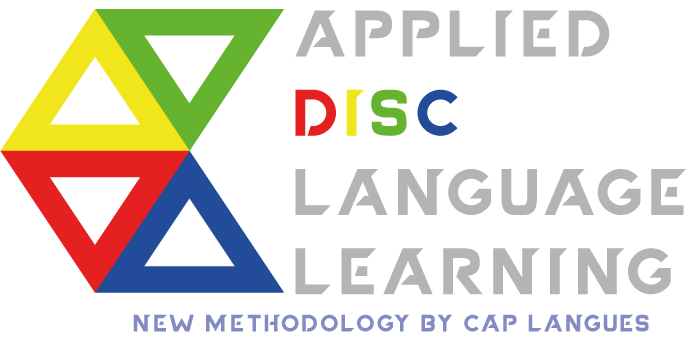Select your language

Profile for a Dominant / Red (D) Learner: Alexandre
- Background: Alexandre is anticipated to be a quick-thinking student who enjoys challenges and thrives on direct interaction and practical application of concepts.
- Adapted Learning Strategy: Alexandre should be assigned stimulating and demanding tasks that require active participation and problem-solving. Alexandre should be given the opportunity to apply his knowledge and skills in real-life situations, in order to boost his sense of achievement and motivation.
- Set clear goals and objectives
- Provide a structured and challenging curriculum
- Foster a competitive environment
- Encourage autonomy and decision-making
- Benefits: These activities are expected to fully engage Alexandre and keep him motivated. This should also serve to drive the group’s energy and focus.
Profile for Influential / Yellow (I) Learners: Brigitte and Romain
- Background: Brigitte and Romain are likely to be enthusiastic students with a penchant for social interactions. They prefer learning through dialogue and collaborative activities.
- Adapted Learning Strategy: Both should excel in settings that involve interactive activities such as discussions, role-plays, games, and group projects. These activities not only cater to their social nature but also provide opportunities for them to practice and apply their language skills in a meaningful way.
- Find the optimal balance between dynamic learning and overwhelm.
- Incorporate interactive activities and visuals
- Provide moments for reflection and processing
- Offer flexibility within structure
- Benefits: Engaging in these dynamic activities is expected to help Brigitte and Romain refine their language skills through practice and interaction, enhancing their ability to learn through cooperation and shared experiences.
Profile for a Steady / Green (S) Learner: Jean
- Background: Jean is expected to appreciate consistency and a methodical approach to learning. Steady Greens value a calm and relaxed learning environment, where they can thoroughly process information and build a solid foundation. Green profiles need scaffolding, it is essential that they are given the tools, time and information to complete tasks, exercises, and activities.
- Adapted Learning Strategy: The course design should incorporate structured learning segments and regular review sessions. The teacher should include activities that allow Jean to use the language in real-life contexts, such as role-plays, simulations, or problem-solving tasks. A practical approach will help connect theory with practice, and solidify his language skills.
- Provide ample time for reflection and analysis.
- Offer structured and organized materials.
- Incorporate hands-on, collaborative and practical activities.
- Be patient and allow for processing time.
- Provide opportunities for in-depth discussions.
- Benefits: Thoughtful pauses and collaborative activities will help Jean achieve a deeper understanding of the material, and give him the confidence to use his language skills more actively.
Profile for Conscientious (C) Blue Learners: Sofia and Sélène
- Background: Sofia and Sélène are expected to be detail-oriented and meticulous. Conscientious Blues thrive in a structured and methodical learning environment.
- Adapted Learning Strategy: Sofia and Sélène's course should be built around a well-structured curriculum that breaks down the language learning process into logical steps and covers topics systematically, with detailed guidelines and step-by-step instructions. Activities should be designed to have clear objectives and outcomes, which will help them understand and meet expectations.
- Establish clear expectations and goals.
- Emphasize accuracy and attention to detail.
- Encourage research and independent study.
- Break down the content into manageable chunks.
- Benefits: This approach will minimize ambiguity, aiding Sofia and Sélène in focusing on their tasks. Engaging conscientious Blue students in the cognitive processes related to language learning encourages them to adapt and apply their communication skills in different contexts.
- Integrated Lesson Planning: Engaging All DISC Profiles Simultaneously.
- Background: The challenge in a diverse classroom is adapting activities to cater for all learner types while taking each profile’s learning preferences into account. To achieve this, activities were structured to simultaneously address the needs of each different DISC profile.
Strategies for Managing Enthusiasm
Implementation of Integrated Activities:
Hybrid Discussion and Structure Activities:
Structured Group Discussions:
I introduced group discussions with a clear, structured format to engage all profiles. These discussions began with a set of specific questions or topics to guide the conversation, appealing to Conscientious students who appreciate clear directions. Simultaneously, the open-ended nature of a discussion allowed Influential students the freedom to express ideas and engage dynamically with peers. With the D student chairing the discussion and the S student note taking and reporting, all learner profiles were addressed during the class.
The Class: We conducted a structured group discussion on "Customer Service Excellence." Conscientious students were given specific questions such as "What are the key elements of effective customer service?" and "How can language impact customer satisfaction?" to help guide the conversation. Influential students were encouraged to lead the discussion by sharing personal experiences and exploring new ideas on the topic; this kept the discussion lively and engaging. The Dominant (D) student, Alexandre, was tasked with chairing the discussion, ensuring that all points on the agenda were covered, and steering the conversation towards actionable outcomes. This role leveraged his leadership tendencies and decision-making skills. The Steady (S) student, Jean, who values a calm and orderly environment, was assigned to take notes and provide summaries the main points. This role allowed him to process information at a comfortable pace and contribute to the group by organizing and clarifying the discussion content.
Role-playing with Defined Roles and Goals: Role-playing exercises were structured with specific roles and objectives. Conscientious students received detailed descriptions of their roles and clear objectives, providing the structure they appreciate. Influential and Dominant (D) students, who thrive on interaction and leadership, were able to take on more dominant or influential roles within the exercises, driving the activity forward. The S student on the other hand was given the role of facilitator.
Example: In a business negotiation role-play, Conscientious students received detailed role cards outlining their characters' backgrounds and negotiation objectives. Influential and Dominant students were assigned roles as team leaders or primary negotiators, allowing them to guide discussions and make strategic decisions, adding to the dynamism of the activity. The S student’s role was to ensure that all parties had an opportunity to speak, clarify points of agreement and disagreement, and guide the group towards a consensus.
Interactive Tutorials with Built-in Reflection Time:
Interactive Tutorials: These sessions were designed to teach new concepts through interactive media, while engaging all learner profiles. To ensure the Steady (S) student was not overwhelmed by the pace, scheduled pauses were integrated into the tutorial to reflect on the material.
The Tutorial:
1. Video Presentation (10 minutes)
Activity: Watch a short video about a business meeting featuring key vocabulary.
Engagement for Different Profiles:
Red (Dominant): Focus on identifying key actions and decisions in the video.
Blue (Conscientiousness): Take detailed notes on specific vocabulary and their contexts.
Green (Steady): Observe how participants in the video communicate and collaborate.
Yellow (Influential): Note the interactions and try to remember the most engaging dialogues.
In this tutorial, each student was able to engage with the material in a way that aligns with their learning preferences while taking part in a group activity. This approach promotes active learning and caters to individual strengths within a collaborative environment.
Collaborative Projects with Individual Contributions: Projects were designed for small groups, where each member was assigned specific tasks that exploited their strengths. This approach ensured that while the project benefitted from the dynamic energy of Influential and Dominant learners, Steady and Conscientious students could work on their parts in a more structured and appropriately paced manner.
The Project:
Creating a Marketing Campaign Proposal
Tasks were assigned to each member based on their strengths and preferences.
Influential: Conceptualize the overall theme and messaging of the campaign.
Dominant: Develop the marketing strategy and outline key objectives.
Steady: Create a detailed timeline and budget plan for the campaign.
Conscientious: Research market trends and competitor analysis to inform the proposal.
Engagement for Different Profiles:
· Influential: Generating creative and innovative ideas to capture audience attention.
· Dominant: Developing a clear and effective marketing strategy that aligns with the campaign goals.
· Steady: Ensuring practicality and consistency of ideas, track timeline and budget.
· Conscientious: Gather accurate and relevant supporting data, maintain attention to detail.
Feedback and Adaptive Adjustments:
Real-time Feedback: During the feedback session, each profile's communication preferences were considered to ensure effective engagement. For Influential students, feedback was delivered in a positive and enthusiastic manner, highlighting their creative contributions and energy. Dominant students received direct, concise feedback based on the effectiveness of their strategies and decision-making in the proposal. The Steady student’s feedback was delivered calmly and reassuringly, based on the consistency and reliability of their contributions. Conscientious students received detailed feedback on the accuracy and thoroughness of their research and analysis. The feedback was intended to foster a supportive and constructive environment that encourages growth and development.
Outcome: This integrated approach meant that no student was left unengaged or felt the activities were mismatched to their learning style. Every part of the class was adapted to keep the different types of learners interested and active, ensuring that learning was both inclusive and effective.
Reflection: “Using an integrated approach allowed me to engage every student simultaneously. It was fascinating to see how different students brought their unique strengths to each activity, making the learning process richer for everyone involved.”
- He established guidelines for discussions to emphasize taking turns to speak and listen.
- Each activity had a specific timeframe to keep students focused.
- Regular sessions allowed students to reflect on their participation and discuss improvements.
Positive Atmosphere and Structured Participation
Floyd fostered a positive atmosphere by encouraging collaboration on creative projects. For example, he assigned Marie and Louis to organize a mock conference in the target language. They planned the agenda and prepared presentations. This project allowed them to use the language creatively and practically while engaging their sociable and enthusiastic nature.
Conclusion
By using the DISC methodology, Floyd effectively managed his students' enthusiasm, creating a positive and dynamic learning experience.







